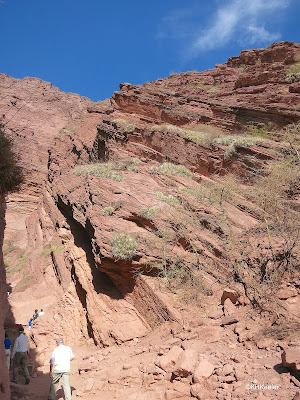Just as in North America, the prevailing winds bring moisture from the Pacific that drops on the mountains, making a dry zone at their base in eastern Oregon and Washington and on the Colorado Front Range, so in South America, the winds from the Pacific leave their water on the west side of the Andes and at the base of the mountains, on the east, it is very dry. This effect is the most dramatic as you approach the tropics, in North America in Arizona and northern Mexico, in South America in northwestern Argentina's Jujuy and Salta Provinces.
 |
| Rocky landscape of Salta Province |
Driving south from the city of Salta, it gets progressively drier. Salta sits in a valley between mountain ranges that most places would impress people, but here they are dwarfed by the Andes.
It became starker and more desert like. Houses were mostly in the river valleys, leaving the uplands apparently uninhabited.
 |
| Small trees growing out of the gravel |
 |
| Eroded and folded land, plants perched between the rocks |
 |
| Dry washes, suggesting wetter times |
The plants were very spiny and dry. They grew scattered across the hillsides, needing a lot of space to get adequate water.
Below, the vehicles show you the scale
 |
| More rocky hillsides |
 |
| huge old shrubs |
Miles of barren lands in increasingly dramatic colors.
 |
| Layers and colors of rock |
The ground was rocky and dry but there were more plants that it seemed from a distance.
 |
| barren rocky ground |
The landscape was a delight. So rough, so colorful, so dry. I saw drought-adapted plants like agaves and cacti. The more I looked the more I saw. A fascinating place.
Comments and corrections welcome.
Kathy Keeler
A Wandering Botanist
More at awanderingbotanist.com
Join me on Facebook: https://www.facebook.com/AWanderingBotanist









No comments:
Post a Comment